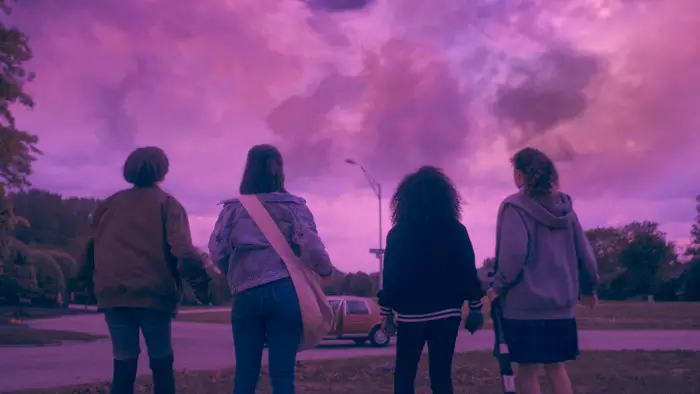Mild spoilers for Paper Girls season 1 ahead.
Last week, I finished reading the Paper Girls comic book series to prepare for the Prime Video series of the same name. The books had their share of emotional moments, but I didn’t cry one time while reading it. While watching the newly-released show, however, I wanted to cry multiple times per episode.
It’s a testament to the added depth the eight episodes of Paper Girls have provided to its primary characters.

Written by Brian K. Vaughan and illustrated by Cliff Chiang, the 30-issue comic book series is a compelling story about a time travel war that features four 12-year-old paper girls at its center. They’ve been inadvertently caught in the crossfire of the chaos and violence and are working toward a way back to their own time.
The Prime Video series, however, transforms the source material. The surprise forces them to quickly grow and learn amidst the turmoil — all while also trying to figure out how to get back home. It’s an ongoing internal battle of looking at what’s to come, whether they can alter outcomes, and how to get back to 1988. The characters stay true to their comic book origins. Now, though, they have several layers to their identities that make them more complex.

The paper girls are played by Camryn Jones (Tiffany Quilkin), Riley Lai Nelet (Erin Tieng), Sofia Rosinsky (Mac Coyle) and Fina Strazza (KJ Brandman). And they’re all tremendous in their respective roles. Each actor nails the characterizations from the start and does a great job tackling their growth and emotional journeys.
On the surface, Paper Girls season 1 stays true to the comics. The narrative begins on Hell Day 1988, the day after Halloween, in Stony Stream, Ohio. Four paper girls wake up early in the morning to deliver newspapers for the fictitious Cleveland Preserver. Only to accidentally be transported to the future.
Throughout its eight episodes, the series makes numerous callbacks to the comic books. From Mac’s brother’s Walkman to the bunk bed Erin shares with her younger sister, comic book readers will come across a myriad of references during the show. But where the Prime Video series strays away from and/or expands upon the comics, it helps strengthen the story.

The show allows the girls the time to have legitimate bonding moments, which isn’t as prevalent in the comics. It elevates the stakes of the overall conflict and strengthens their friendships. The girls’ discussion about pets during their first night at adult Erin’s house is a great instance of this. It feels incredibly “normal,” as though they’re at a slumber party, sharing stories and laughs and just being kids.
There are also smaller — in size — examples of this. Erin and Mac’s friendship, in particular, undergoes nice development as the series progresses. What begins as Erin being shy and apprehensive with Mac evolves into them confiding and supporting each other with personal matters.
One of the themes seen throughout the first season is the idea of expectation versus disappointment and the self-reflection that comes with it. The series primarily explores the concept as each girl encounters her future self — whether that be literally coming face-to-face with her adult self or knowing what her future holds. But other important themes like racism, sexuality, and puberty all have their places in the show, and it addresses them well. (The tampon scene is amusing and painful in that it’s very relatable.)

The time travel war between the Standard Time Fighters and the Old Watch might be an important aspect of the overarching narrative. But it feels a bit pushed to the side. And it makes the show feel more like a drama with science fiction elements than a true sci-fi drama. This isn’t necessarily a bad thing, though. It allows the story to truly place the girls front and center and prioritize their journeys.
The war is a smaller part of their general conflict instead of the girls being a smaller part of the war. The show explains and incorporates the backstory of the war and the opposing sides well enough that it’s easy to grasp where it all fits into the series.
If the show gets a second season (please, Prime Video), it’s seemingly set up to smoothly get more in-depth with the war. This is even more so when considering the source material.
All eight episodes of Paper Girls season 1 are streaming now on Prime Video.

